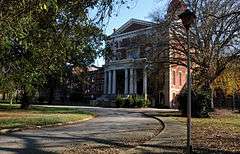Babcock Building, South Carolina State Hospital
|
Babcock Building, South Carolina State Hospital | |
 | |
  | |
| Location | Columbia, South Carolina |
|---|---|
| Coordinates | 34°0′51″N 81°01′49″W / 34.01417°N 81.03028°WCoordinates: 34°0′51″N 81°01′49″W / 34.01417°N 81.03028°W |
| Built | 1858-1885 |
| Architect | George E. Walker; Samuel Sloan; Gustavus T. Berg[1] |
| Architectural style | Italian Renaissance Revival[1] |
| NRHP Reference # | 81000570[1] |
| Added to NRHP | October 30, 1981 |
The Babcock Building is an historic structure located off Bull St. in Columbia, South Carolina. It was added to the National Register of Historic Places on October 30, 1981.[2] The building is the second to house patients on the campus of South Carolina State Hospital, after the Mills Building proved to be insufficient in space to house its patients.
Construction
The first section of Babcock, was designed by George E. Walker in 1858. Walker died before the south wing was complete. The north wing was overseen by Gustavus T. Berg. The central portion, bearing the name and serving as the main entrance, was designed by architect Samuel Sloan. The structure was completed in 1885 after four building campaigns. Construction delays were the fault of funding and the American Civil War.[3] Through the years, additions were made to the building, including stairwells whose style and materials do not match that of the rest of the building. Several buildings were constructed directly adjacent to Babcock, but have since been removed.
Style
Following the Kirkbride Plan, Babcock was designed not to include subterranean housing of patients. Each wing of the structure is 3-4 stories with rooms broken up into manageable wards. For its time, the building was heavily fireproofed. It also utilized, for a time, gas lighting. The building does not completely comply with Kirkbride standards. Babcock does not have staggered blocks within its wings, as would be seen in a true Kirkbride.[4] South Carolina Lunatic Asylum head physician Dr. Trezevant successfully argued that the staggering of blocks would not allow the ventilation needed for the warm southern climate. However, against Trezevant's wishes, the halls were built in a double-range, with rooms on either side of the hallway.
Babcock is noted as a particularly fine example of Italian Renaissance Revival architecture.[5] Walker was previously known for his work in Romanesque and Gothic Revival. Though he died before even his own section was complete, his work became the basis for the rest of the building's construction. Berg's Northern wing mirrors the design of the original in many ways.
Sloan's central section is crowned with a now iconic, twelve-sided cupola whose red domed roof can be seen from far across the city.[3] This section also features the operating rooms, dormitories for staff, offices, and a chapel. Dining halls were added to the Eastern end of the central block in 1916.
Historic uses
- Health care
- Filming location for Chattahoochee[6]
Further reading
Videos
- Columbia - Kirkbrides HD on Vimeo, 2009
See also
References
- 1 2 3 National Park Service (2010-07-09). "National Register Information System". National Register of Historic Places. National Park Service.
- ↑ National Register of Historic Places listings in Columbia, South Carolina
- 1 2 http://www.naiavantbullstreet.com/pdfs/Item%20V%20a%20-%20Archives%20_and_%20History%20-%20National%20Register%20Nomination.pdf
- ↑ Babcock Building – South Carolina State Hospital — rustyjaw
- ↑ Babcock Building, SC — Amy Heiden
- ↑ Wierd in South Carolina Department of Mental Health (Bull Street) 2414 Bull St Columbia, SC 29202 Columbia, SOUTH CAROLINA Richland Wierd

